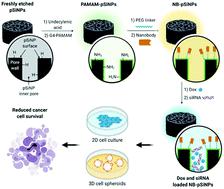当前位置:
X-MOL 学术
›
Biomater. Sci.
›
论文详情
Our official English website, www.x-mol.net, welcomes your feedback! (Note: you will need to create a separate account there.)
Nanobody-displaying porous silicon nanoparticles for the co-delivery of siRNA and doxorubicin
Biomaterials Science ( IF 6.6 ) Pub Date : 2020-10-28 , DOI: 10.1039/d0bm01335h Terence Tieu 1, 2, 3, 4, 5 , Marcin Wojnilowicz 4, 5, 6 , Pie Huda 7, 8, 9, 10, 11 , Kristofer J. Thurecht 7, 8, 9, 10, 11 , Helmut Thissen 4, 5, 6 , Nicolas H. Voelcker 1, 2, 3, 4, 5 , Anna Cifuentes-Rius 1, 2, 3, 4
Biomaterials Science ( IF 6.6 ) Pub Date : 2020-10-28 , DOI: 10.1039/d0bm01335h Terence Tieu 1, 2, 3, 4, 5 , Marcin Wojnilowicz 4, 5, 6 , Pie Huda 7, 8, 9, 10, 11 , Kristofer J. Thurecht 7, 8, 9, 10, 11 , Helmut Thissen 4, 5, 6 , Nicolas H. Voelcker 1, 2, 3, 4, 5 , Anna Cifuentes-Rius 1, 2, 3, 4
Affiliation

|
Targeted delivery of chemotherapeutics to cancer cells has the potential to yield high drug concentrations in cancer cells while minimizing any unwanted side effects. However, the development of multidrug resistance in cancer cells may impede the accumulation of chemotherapy drugs within these, decreasing its therapeutic efficacy. Downregulation of multidrug resistance-related proteins such as MRP1 with small interfering RNA (siRNA) is a promising approach in the reversal of drug resistance. The co-delivery of doxorubicin (Dox) and siRNA against MRP1 (siMRP1) by using nanoparticles comprised of biocompatible porous silicon (pSi) presents itself as a novel opportunity to utilize the biomaterial's high loading capacity and large accessible surface area. Additionally, to increase the selectivity and retention of the delivery vehicle at the tumor site, nanobodies were incorporated onto the nanoparticle surface via a polyethylene glycol (PEG) linker directed towards either the epidermal growth factor receptor (EGFR) or the prostate specific membrane antigen (PSMA). The nanobody-displaying pSi nanoparticles (pSiNPs) demonstrated effective gene silencing, inhibiting MRP1 expression by 74 ± 6% and 74 ± 4% when incubated with EGFR-pSiNPs and PSMA-pSiNPs, respectively, in prostate cancer cells. The downregulation of MRP1 led to a further increase in cytotoxicity when both siRNA and Dox were delivered in conjunction in both cancer cell monocultures and spheroids when compared to free Dox or Dox and a scrambled sequence of siRNA. Altogether, nanobody-displaying pSiNPs are an effective carrier for the dual delivery of both siRNA and Dox for cancer treatment.
中文翻译:

用于siRNA和阿霉素共递送的展示纳米抗体的多孔硅纳米颗粒
将化学疗法靶向递送至癌细胞具有在癌细胞中产生高药物浓度同时最小化任何不希望的副作用的潜力。但是,癌细胞中多药耐药性的发展可能会阻止化疗药物在其中的积累,从而降低其治疗效果。用小干扰RNA(siRNA)下调与多药耐药性相关的蛋白质,例如MRP1,是逆转耐药性的一种有前途的方法。通过使用由生物相容性多孔硅(pSi)组成的纳米粒子,阿霉素(Dox)和siRNA共同针对MRP1(siMRP1)的联运将自身作为利用生物材料的高负载能力和大可及表面积的新机会。另外,通过针对表皮生长因子受体(EGFR)或前列腺特异性膜抗原(PSMA)的聚乙二醇(PEG)接头。展示纳米抗体的pSi纳米颗粒(pSiNPs)在前列腺癌细胞中显示出有效的基因沉默,分别与EGFR-pSiNPs和PSMA-pSiNPs孵育时,抑制MRP1表达的程度分别为74±6%和74±4%。当与游离Dox或Dox和杂乱的siRNA序列相比时,在癌细胞单培养物和球体中同时递送siRNA和Dox时,MRP1的下调导致细胞毒性进一步增加。总而言之,展示纳米抗体的pSiNPs是用于siRNA和Dox双重递送以治疗癌症的有效载体。
更新日期:2020-11-03
中文翻译:

用于siRNA和阿霉素共递送的展示纳米抗体的多孔硅纳米颗粒
将化学疗法靶向递送至癌细胞具有在癌细胞中产生高药物浓度同时最小化任何不希望的副作用的潜力。但是,癌细胞中多药耐药性的发展可能会阻止化疗药物在其中的积累,从而降低其治疗效果。用小干扰RNA(siRNA)下调与多药耐药性相关的蛋白质,例如MRP1,是逆转耐药性的一种有前途的方法。通过使用由生物相容性多孔硅(pSi)组成的纳米粒子,阿霉素(Dox)和siRNA共同针对MRP1(siMRP1)的联运将自身作为利用生物材料的高负载能力和大可及表面积的新机会。另外,通过针对表皮生长因子受体(EGFR)或前列腺特异性膜抗原(PSMA)的聚乙二醇(PEG)接头。展示纳米抗体的pSi纳米颗粒(pSiNPs)在前列腺癌细胞中显示出有效的基因沉默,分别与EGFR-pSiNPs和PSMA-pSiNPs孵育时,抑制MRP1表达的程度分别为74±6%和74±4%。当与游离Dox或Dox和杂乱的siRNA序列相比时,在癌细胞单培养物和球体中同时递送siRNA和Dox时,MRP1的下调导致细胞毒性进一步增加。总而言之,展示纳米抗体的pSiNPs是用于siRNA和Dox双重递送以治疗癌症的有效载体。



























 京公网安备 11010802027423号
京公网安备 11010802027423号